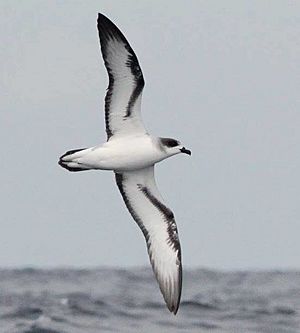Barau's petrel facts for kids
Quick facts for kids Barau's petrel |
|
|---|---|
 |
|
| Conservation status | |
| Scientific classification | |
| Genus: |
Pterodroma
|
| Species: |
baraui
|
The Barau's petrel (Pterodroma baraui) is a special seabird. It is a medium-sized bird. This petrel belongs to the Procellariidae family. Its main breeding place is Réunion Island. Réunion is an island in the Indian Ocean.
Contents
Why Is It Called Barau's Petrel?
The Barau's petrel is named after Armand Barau. He was an agricultural engineer. He was also a bird expert, called an ornithologist. Armand Barau lived on Réunion Island. This bird was officially described in 1964. However, local people knew about it before then. It is one of the most recently discovered seabird species.
What Does Barau's Petrel Look Like?
Barau's petrel is about 40 cm (16 inches) long. It has white undersides and a white forehead. The bird's bill is black. Its upper parts are dark. You can see a faint "M" pattern across its wings and back.
Where Do Barau's Petrels Live?
Barau's petrels fly across the Indian Ocean. They travel from Réunion Island to Western Australia and Indonesia. Most of these birds nest on Réunion Island. Only one nest has been found on Rodrigues Island.
How Do Barau's Petrels Behave?
How Do They Find Food?
These petrels spend most of their time far out at sea. This is called being pelagic. They hunt for small fish, about 10 cm long. They catch fish by grabbing them from the surface. They also dive into the water. Sometimes, they feed with other bird species.
How Do They Raise Their Young?
Barau's petrels have unusual nesting places. Their colonies are far inland. They are also high up in the mountains. They dig burrows under the forest. These burrows are about 2,400 to 2,700 meters above sea level.
Scientists think the eggs hatch after about 55 days. The chicks then take about 100 to 120 days to fly. This is called fledging. Unlike most burrow-nesting birds, Barau's petrels return to their nests during the day. They come back in the late afternoon. They use warm air currents to save energy. The young birds fledge between November and February.
Important areas for these birds are on Réunion Island. These include the Grand Bénard – Tapcal and Piton des Neiges – Gros Morne areas. These places are important for their breeding colonies.
Why Is Barau's Petrel Endangered?
Barau's petrel is an endangered species. This means it is at risk of disappearing. They only breed in a small area. In the past, people used to hunt them. Hunting has now stopped. The bird population seems to have grown back.
However, new dangers exist. These include introduced species and light pollution. Introduced species are animals brought by humans. They can harm the petrels. Light pollution is a big problem for young birds. Streetlights and stadium lights confuse them. They mistake these lights for glowing squid in the ocean. This makes them fly away from the sea. They cannot reach the ocean.
It is thought that 40% of young birds get confused each year. Conservation groups help these lost chicks. They work with local people to catch the confused birds. Then, they release them safely back at sea. This program saves many young petrels. Efforts are also being made to reduce light pollution. Lights are shielded so they do not attract the birds. This method has also helped Newell's shearwaters in Hawaii.
See also
 In Spanish: Petrel de Barau para niños
In Spanish: Petrel de Barau para niños



